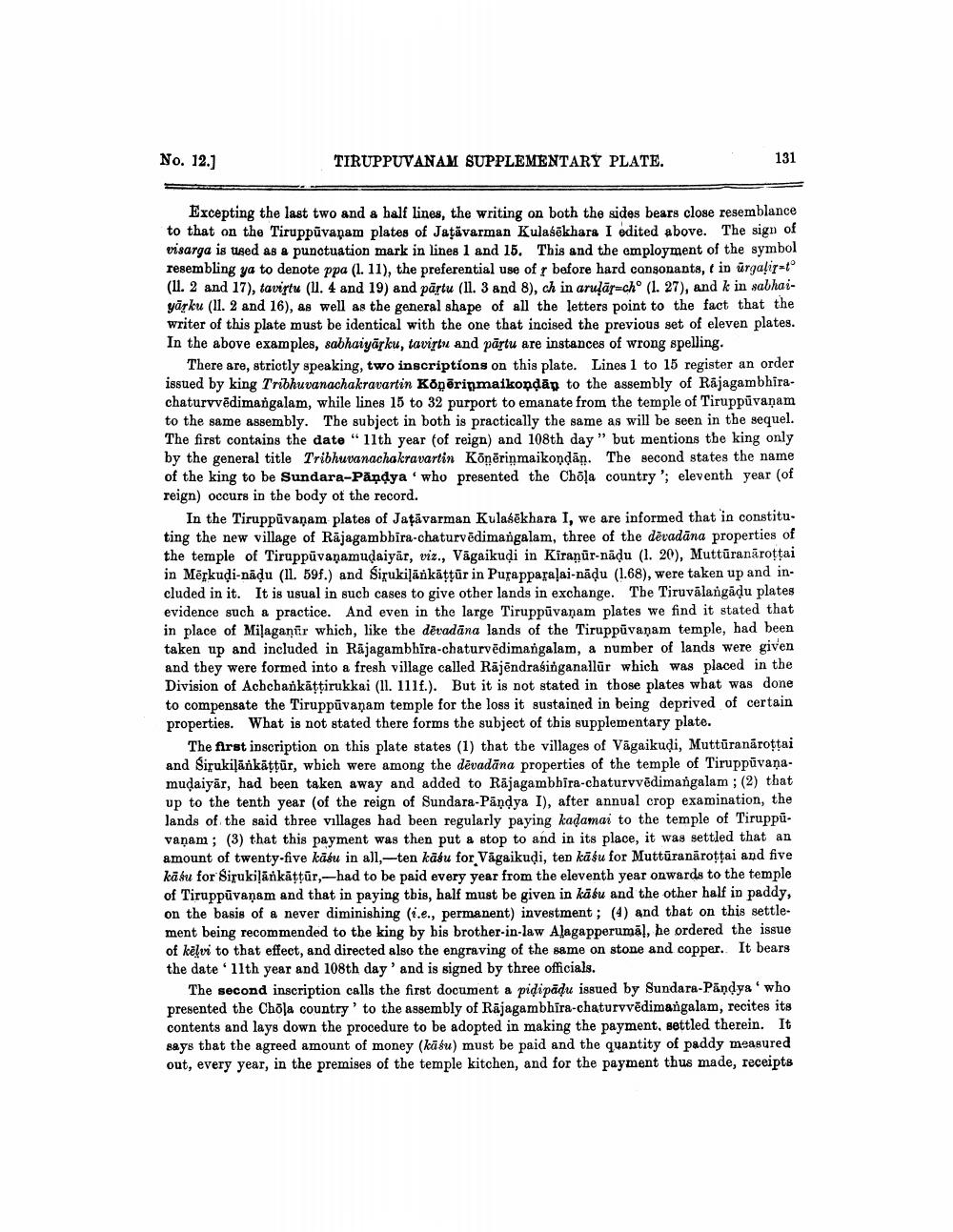________________
No. 12.)
TIRUPPUVANAM SUPPLEMENTARY PLATE.
131
Excepting the last two and a half lines, the writing on both the sides bears close resemblance to that on the Tiruppuvapam plates of Jatavarman Kulasēkhara I edited above. The sign of visarga is tised as a punctuation mark in lines 1 and 15. This and the employment of the symbol resembling ya to denote ppa (1.11), the preferential use of r before hard consonants, t in urgalir(11. 2 and 17), tavirtu (1. 4 and 19) and pārtu (11. 3 and 8), ch in arulärucho (1. 27), and k in sabhaiyārku (11. 2 and 16), as well as the general shape of all the letters point to the fact that the writer of this plate must be identical with the one that incised the previous set of eleven plates. In the above examples, sabhaiyārku, tavistu and pārtu are instances of wrong spelling.
There are, strictly speaking, two inscriptions on this plate. Lines 1 to 15 register an order issued by king Tribhuvanachakravartin Kopēriņmaikonday to the assembly of Rajagambhirachaturvvēdimangalam, while lines 15 to 32 purport to emanate from the temple of Tiruppūvanam to the same assembly. The subject in both is practically the same as will be seen in the sequel. The first contains the date "11th year (of reign) and 108th day" but mentions the king only by the general title Tribhuvanachakravartin Kõnērinmaikondān. The second states the name of the king to be Sundara-Pāņdya 'who presented the Chola country'; eleventh year (of reign) occurs in the body of the record.
In the Tiruppūvanam plates of Jaţăvarman Kulasēkhara I, we are informed that in constituting the new village of Rājagambbira-chaturvēdimangalam, three of the dēvadāna properties of the temple of Tiruppūvanamudaiyar, viz., Vägaikudi in Kiranür-nädu (1. 20), Muttūranārottai in Mērkuļi-nāļu (11. 59f.) and Sirukiļārkāţtūr in Purapparaļai-nādu (1.68), were taken up and included in it. It is usual in such cases to give other lands in exchange. The Tiruvālangādu plates evidence such a practice. And even in the large Tiruppūvanam plates we find it stated that in place of Milaganür which, like the dēvadāna lands of the Tiruppuvanam temple, had been taken up and included in Räjagambhira-chaturvēdimangalam, a number of lands were given and they were formed into a fresh village called Rājēndrasinganallur which was placed in the Division of Acbcbankāțtirukkai (11. 111f.). But it is not stated in those plates what was done to compensate the Tiruppūvanam temple for the loss it sustained in being deprived of certain properties. What is not stated there forms the subject of this supplementary plate.
The first inscription on this plate states (1) that the villages of Vägaikudi, Muttūranarottai and Sisukiļārkāttür, which were among the dēvadāna properties of the temple of Tiruppūvanamudaiyār, had been taken away and added to Rājagambhira-chaturvvēdimangalam ; (2) that up to the tenth year of the reign of Sundara-Pāņdya I), after annual crop examination, the lands of the said three villages had been regularly paying kadamai to the temple of Tiruppuvaņam; (3) that this payment was then put a stop to and in its place, it was settled that an amount of twenty-five käsu in all, ten käsu for Vägaikudi, ten käsu for Muttüranārotai and five käsu for Sirukilārkāttur,--had to be paid every year from the eleventh year onwards to the temple of Tiruppuvaņam and that in paying this, half must be given in kāśu and the other half in paddy, on the basis of a never diminishing (i.e., permanent) investment; (4) and that on this settlement being recommended to the king by bis brother-in-law Alagapperuma], he ordered the issue of kēļvi to that effect, and directed also the engraving of the same on stone and capper. It bears the date 11th year and 108th day' and is signed by three officials.
The second inscription calls the first document a pidipādu issued by Sundara-Pāņdya' who presented the Chola country to the assembly of Rājagambhira-chaturvvēdimangalam, recites its contents and lays down the procedure to be adopted in making the payment, settled therein. It says that the agreed amount of money (kāśu) must be paid and the quantity of paddy measured out, every year, in the premises of the temple kitchen, and for the payment thus made, receipts




